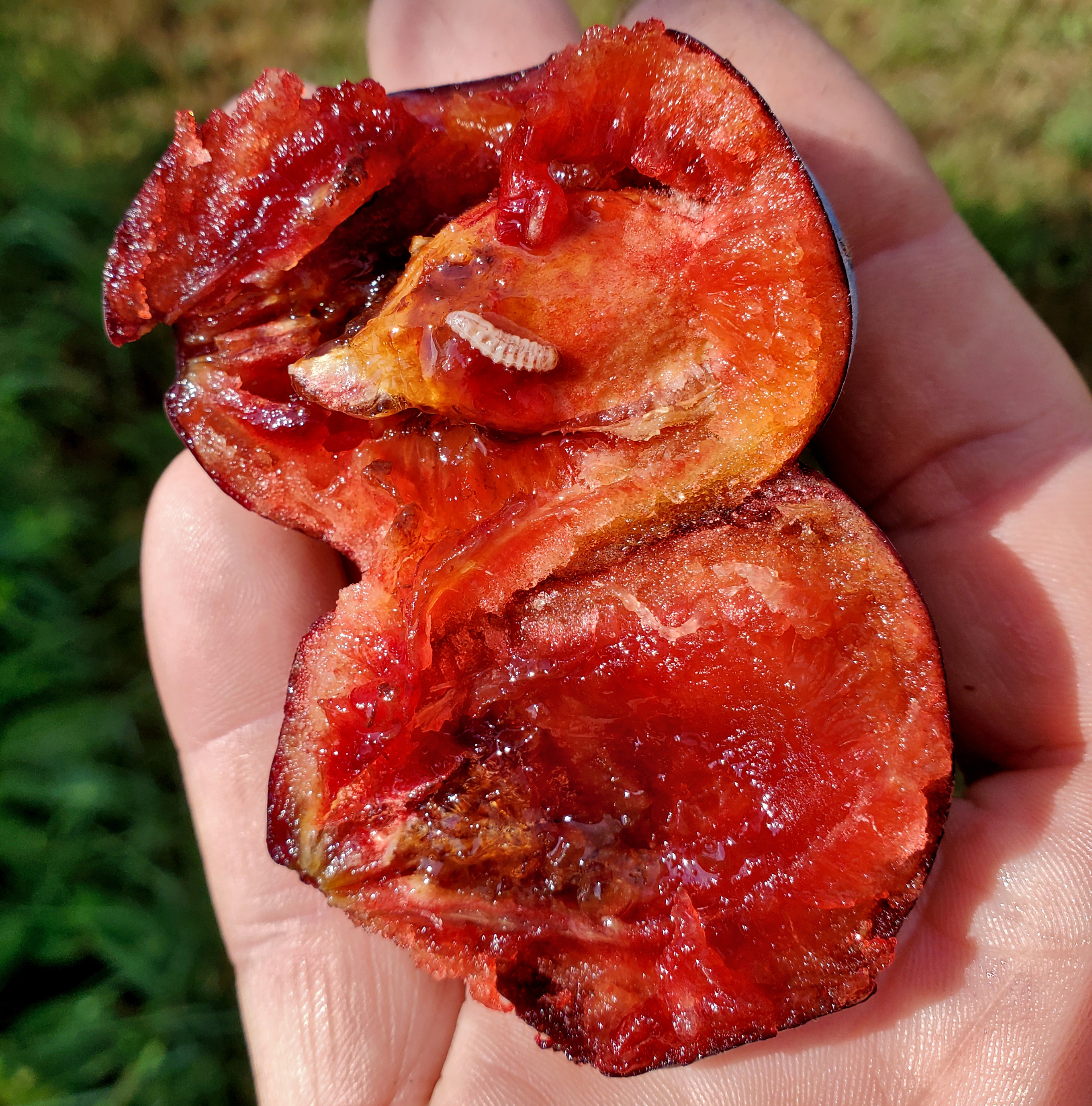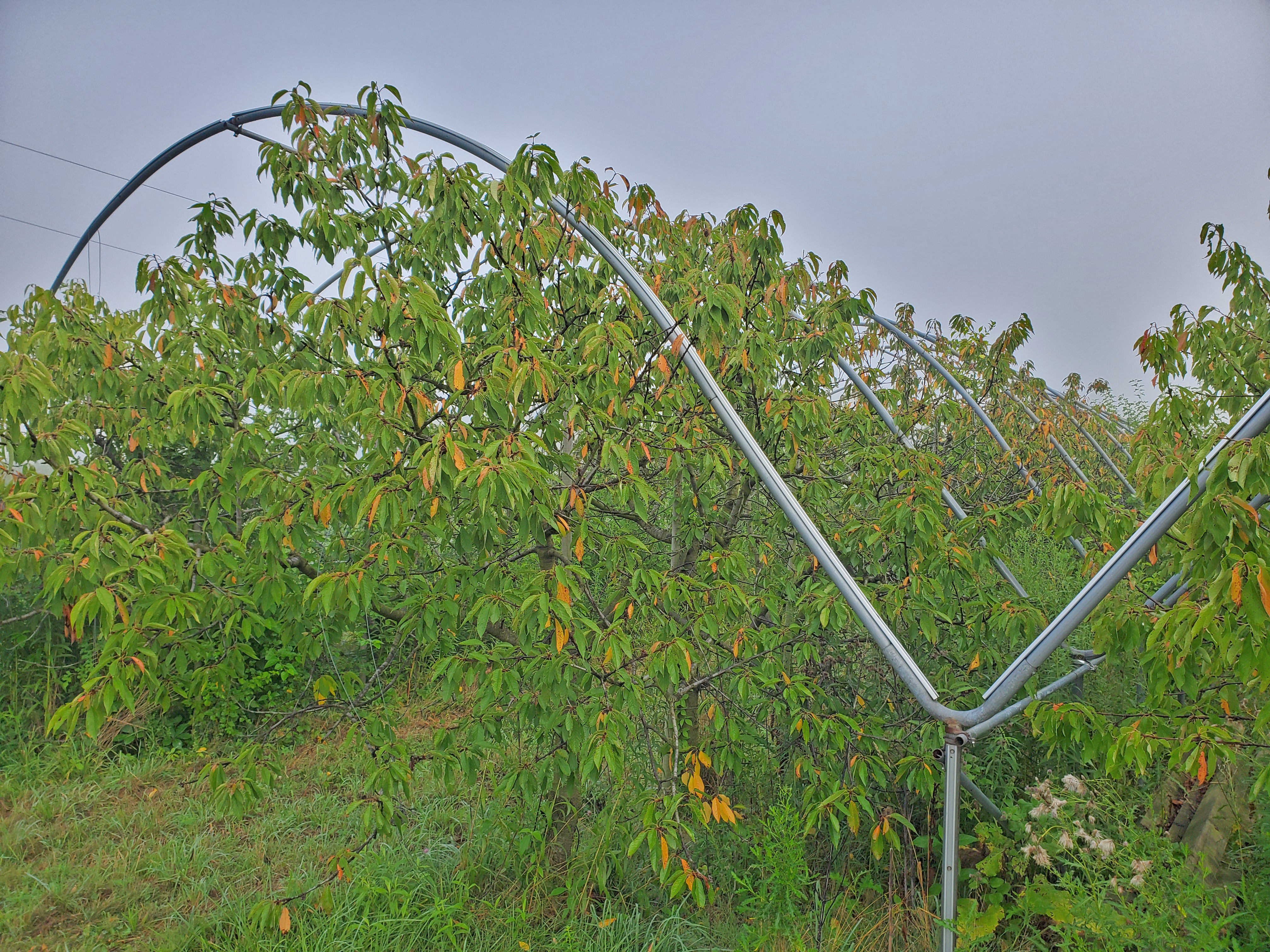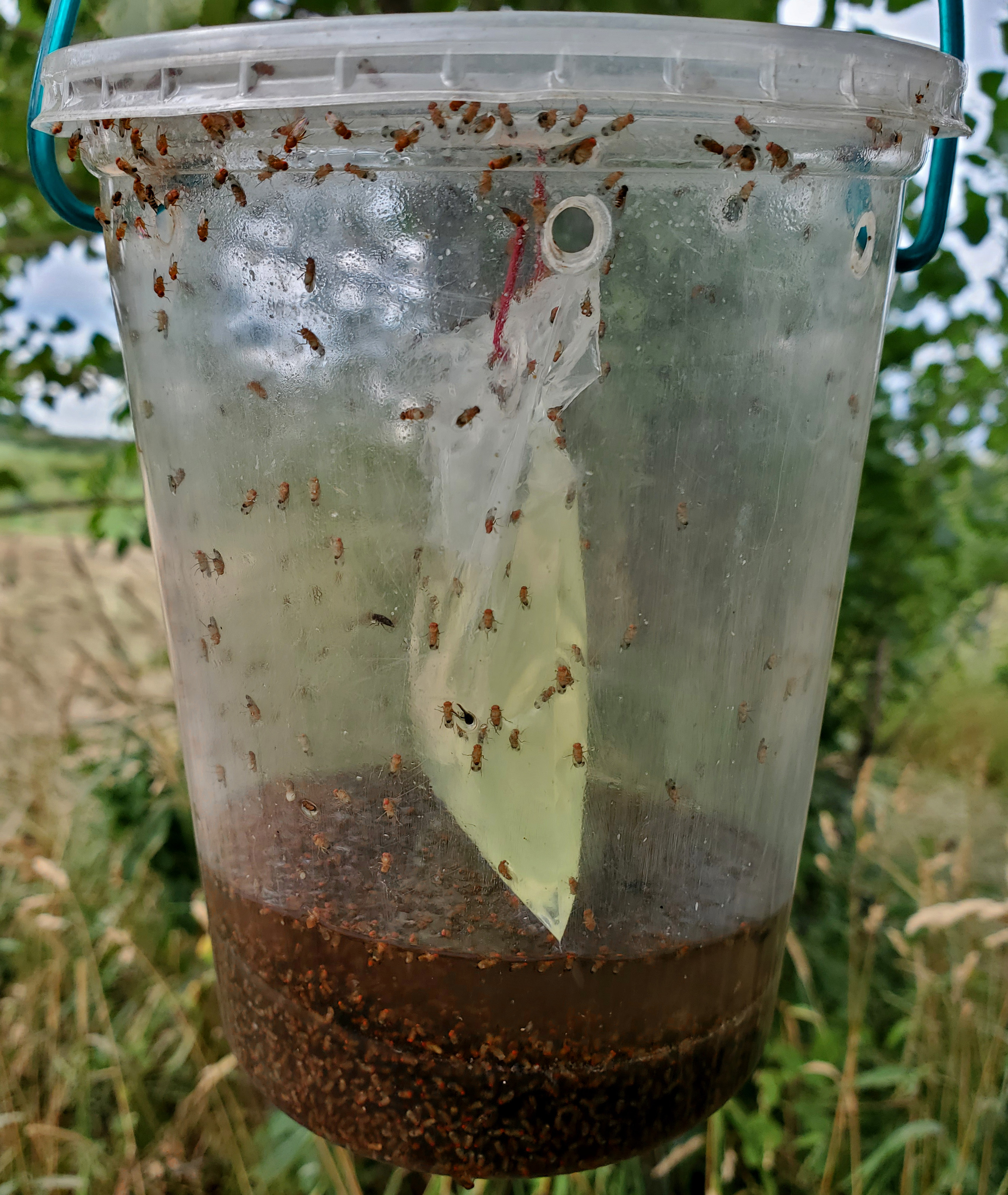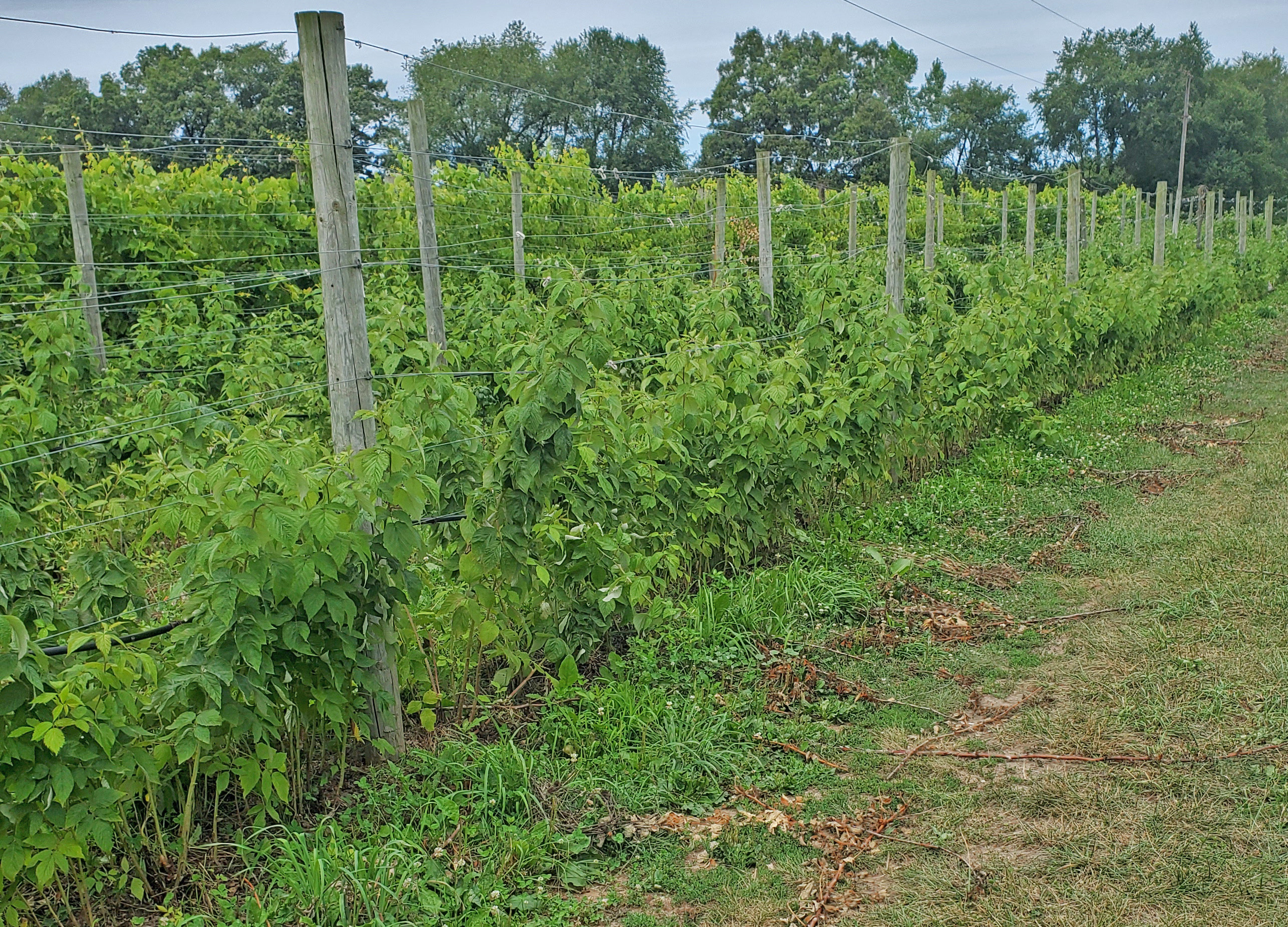Southwest Michigan fruit update – Aug. 4, 2020
Brown marmorated stink bug nymphs and adults are being caught.

Weather
Last week was a cool break from the warm, humid July we have seen this year. Most days had highs in the low 80s. Light scattered showers were recorded on several days, but the main rain event was on Sunday, Aug. 2. Unfortunately, these rains were very spotty. Some places saw over an inch of rain, but many others saw very little. This week will stay cool with highs in the low to mid-70s for much of the week, climbing to the low 80s for the weekend. The best chance of rain for the week will come Sunday.
With the cooler week, we picked up fewer growing degree days (GDD) last week: 210 GDD base 42 and 154 GDD base 50, respectively 30 and 22 per day.
|
Southwest Michigan GDD summary from March 1 – Aug. 2, 2020 | |||
|---|---|---|---|
|
Station |
GDD 42 F |
GDD 45 F |
GDD 50 F |
|
Benton Harbor (SWMRC) |
2671 |
2335 |
1822 |
|
Lawton (Lawton) |
2648 |
2308 |
1791 |
|
Fennville (TNRC) |
2474 |
2146 |
1646 |
|
Average for the SW region |
2628 |
2291 |
1778 |
|
Average last week |
2418 |
2102 |
1624 |
Tree fruit
Rainfall for the month of July is about 1 inch short of normal in some areas, putting trees on sandy sites into some stress. Codling moth and obliquebanded leafroller flights continue. Brown marmorated stink bug adults from the summer generation are showing up now. Leaf samples for foliar tissue analysis should be collected from mid-July to mid-August. San Jose scale summer generation male flight is in its second week, according to the Trevor Nichols Research Center trapline in Allegan County. Crawlers are expected approximately 400 to 450 degree days base 51 F after biofix (estimated to be July 27), or approximately mid-August.

In peaches and nectarines, Risingstar, Summer Serenade and Saturn have been harvested over the past week with Redhaven harvest starting soon, a few days later than the predicted date in central Berrien County. Recent rains have helped to size fruit. Brown rot is becoming more common on split pits and fruit damaged by insects. Luna Sensation and Merivon are both SDHI plus strobilurin fungicides effective on brown rot. Oriental fruit moth larvae entries into fruit are being seen now. Leaf drop and fruit marking due to bacterial spot is showing up on susceptible varieties. Fruit speckles due to bacterial spot is common on varieties with fruit resistance but poorer leaf resistance to this disease.
In cherries, sweet and tart cherry harvests are complete. Cherry leaf spot symptoms are common in the tops of many trees. To prepare the trees for the winter and next year’s crop, continue to protect the leaves from cherry leaf spot. See: Low spray programs for tart cherry.

Plum harvest of Shiro, Vibrant, Vanette, Morris and Santa Rosa have started in some locations. Brown rot is showing up on fruit damaged by insects. Mature plum curculio larvae are being seen in ripening plums. Plums held on the tree until soft ripe are susceptible to spotted wing Drosophila (SWD) attack.
Apple fruit are 2-plus inches in diameter. The sooty blotch and flyspeck model predicts that infections of these diseases are likely established in orchards and need ongoing treatment, with reapplication when rain has likely reduced coverage. Apple maggot emergence is increasing. Place traps to monitor susceptible sites. Codling moth and oriental fruit moth entries into fruit are also showing up now.
Pear Bartlett fruit are large enough to be susceptible to codling moth damage. Like apples, protect pears against sooty blotch and fly speck. Pear psylla are easier to find.
Small fruit
Japanese beetle populations are decreasing. Spotted wing Drosophila (SWD) numbers are rising in southwest Michigan with cooler, humid weather. We are seeing traps with catches in the hundreds of flies. SWD numbers increase rapidly in August. Leaf samples for foliar tissue analysis should be collected from mid-July to mid-August.

Many hybrid grapes are beginning veraison. Veraison should begin soon in Vinifera and juice grapes. The disease focus now is on preventing or reducing the spread of downy mildew and powdery mildew. Choose fungicides carefully to control both diseases. Downy mildew favors wet conditions and spreads rapidly now that we have heavy dews almost every morning. Scout for downy mildew on the leaves and protect the leaves from infection. Downy mildew can defoliate the vines in August. Powdery mildew does not need free water. It prefers high humidity and warm weather. Powdery mildew seems to be widespread this year.
As clusters close, remember botrytis bunch rot. To reduce this disease at harvest, good fungicide coverage is needed inside clusters now.
The start of egglaying from the third generation of grape berry moth should start this week (1620 GGD after biofix). Wild grape bloom is used as biofix for the grape berry moth model predicting timing for insecticide sprays. For 2020, approximate wild grape bloom dates are June 2 in Berrien and June 4 in Van Buren counties. This date can be entered into the grape berry moth model in Enviroweather to predict when egglaying will start for the third generation of berry moth. Using the approximate bloom dates above, the start of egglaying is Aug. 2 in Berrien and Aug. 7 in Van Buren counties.
Maintain good insecticide coverage for the remainder of the season for grape berry moth. For information on what to use and when, see: Mid-season management of grape berry moth. For growers who have had trouble with grape berry moth in the past, more than one spray may be needed about two weeks after the first.
Blueberry harvest is continuing. Growers are finishing up Bluecrop and Jersey harvest is underway. Growers in the south are beginning Elliott harvest. Phomopsis cane collapse seems to have stopped. Maintain irrigation even after harvest to maintain plant vigor into the fall.
Keep tight coverage for SWD. SWD really like the cooler conditions. SWD numbers usually climb quickly in August.
New strawberry growth is looking good in renovated fields. Maintain protection against potato leafhopper and leaf spot diseases.
Bramble harvest of summer red raspberry is winding down in the heat. Remove the spent floricanes to increase air circulation in the row and reduce disease pressure on the new primocanes. Blackberry harvest is underway.
SWD is the major insect pest of brambles and can destroy the crop quickly. Treat SWD as a disease and focus on keeping it out. Do not let this pest become established in the field. Pick ripe fruit frequently so that ripe fruit are not available to the pest for long.

Related resources
- Southwest Michigan fruit update – July 28, 2020
- Low spray programs for tart cherry.
- SDHI fungicides for apple scab management
- Michigan grape scouting report – July 29, 2020
- Managing botrytis bunch rot in grapes
- Irrigating Michigan blueberries
- Michigan spotted wing Drosophila update – July 28, 2020
- Blueberry growers need to focus on Anthracnose fruit rot as bloom ends
- Michigan Blueberry Facts: Anthracnose Fruit Rot
- Mid-season management of grape berry moth



 Print
Print Email
Email




